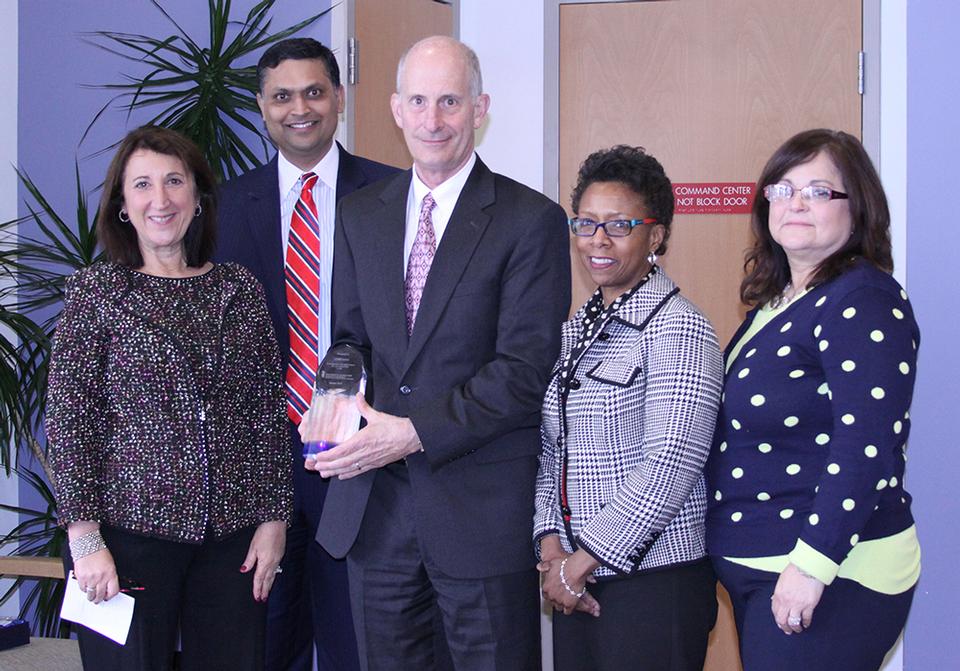FDA Awards Two Grants, $1.2 Million to Center for Translational Medicine
Grants will support the development of quantitative pharmacometric models to advance the evaluation of generic drugs.
By Malissa Carroll
January 12, 2015
The Food and Drug Administration (FDA) has awarded two major grants totaling $1.2 million to researchers from the Center for Translational Medicine (CTM) at the University of Maryland School of Pharmacy. The grants will support two research initiatives within the Center that aim to develop quantitative pharmacometric models to advance the evaluation of generic drugs, specifically in the areas of narrow therapeutic index (NTI) drugs, generic drug substitutability, and post-marketing risk assessment.
“We are very pleased to have our Center’s leadership in the field of translational medicine recognized by the FDA through the awarding of these two prestigious grants,” says Joga Gobburu, PhD, MBA, FCP, professor in the Department of Pharmacy Practice and Science (PPS) and director of the CTM. “These grants represent an important step in the progress of our Center, which was only recently established in 2012.”
The first three-year grant for $600,000 will support a project led by Vijay Ivaturi, PhD, research assistant professor in PPS. Titled “Population Pharmacokinetic-Pharmacodynamic, Dose-Toxicity Modeling and Simulation for Narrow Therapeutic Index Drugs,” this project will combine the Center’s scientific expertise with sound public health judgment to develop objective criteria that better define NTI drugs and develop new metrics to help evaluate whether new generic NTI drugs are bioequivalent to existing NTI drugs on the market.
“In 1984, Congress passed the Hatch-Waxman Act, which allowed generic drugs to be approved through an abbreviated approval process,” says Ivaturi. “It was thought that this act would encourage competition among drug manufacturers and help lower the cost of medications. However, there are concerns about whether this abbreviated approval process should extend to NTI drugs, for which a small change in dose can impact both the drug’s effectiveness and toxicity.”
Characterized by their narrow therapeutic range, NTI drugs display little difference between therapeutic (helpful) and toxic (harmful) doses. These drugs are often prescribed for life-threatening illnesses and require close monitoring by a health care provider. Some medications currently classified as NTI drugs include antiarrhythmic drugs, levothyroxine (for hypothyroidism), antiepileptic drugs, warfarin, and transplant or anti-rejection medications.
Ivaturi notes that the decision about whether to extend the abbreviated approval process to NTI drugs is complicated by the lack of formal criteria to define NTI drugs – criteria that his team aims to provide through its study.
“Having formal criteria to better define NTI drugs will allow researchers to investigate whether the abbreviated approval process is as effective for these drugs as it has been for other generic drugs,” adds Ivaturi. “Combine this with the improved metrics that our team will develop to evaluate the bioequivalency of new generic NTI drugs, and our research has the potential to significantly improve productivity in the area of drug development.”
The second three-year grant for $600,000 will support a project led by Mathangi Gopalakrishnan, MS, PhD, research assistant professor in PPS. Titled “Pharmacometric Modeling and Simulation for a Generic Drug Substitutability Evaluation and Post-Marketing Risk Assessment,” this project will use a Bayesian pharmacometric approach to develop an application that researchers at the FDA will use to help filter and analyze complaints about generic drugs reported by patients and health care providers.
“There is a concern among the general public that generic drugs are not as effective as brand-name drugs because they are approved through an abbreviated approval process,” says Gopalakrishnan. “There is often an increase in complaints when patients are switched from the brand-name drug to the generic drug, with many individuals reporting that their symptoms returned after the switch. Currently, the FDA does not have the resources to analyze and respond to all of the complaints that it receives.”
According to the FDA, generic drugs are equivalent to brand-name drugs in dosage form, strength, route of administration, quality, performance characteristics, and intended use. However, unlike brand-name drugs — whose manufacturers must submit a new drug application with complete supportive data — generic drug manufacturers are permitted to seek approval for their drugs through an abbreviated approval process by demonstrating that their drug is bioequivalent to the brand-name drug – its active ingredients must work in the same way and in the same amount of time as those in the brand-name drug.
Gopalakrishnan and her team will use post-marketing surveillance reports collected from private, non-profit, and government databases to develop an application that will help researchers at the FDA validate the generic drug complaints received by patients and health care providers. Using special codes, the application will alert researchers to those complaints that require immediate action.
“Through the implementation of our application, we aim to ease the public’s concerns about the efficacy of generic medications by improving the monitoring and response to generic drug complaints received by the FDA,” adds Gopalakrishnan.
Housed in PPS, the CTM was established to help eliminate the silos in which research into pharmaceutical innovations is conducted. The Center employs advanced and innovative analyses to create intelligence from information, analyzing and summarizing data from experiments and clinical trials using quantitative disease, drug, and trial models. Researchers at the Center integrate those quantitative models, along with cutting-edge development techniques such as adaptive and enrichment trials, into tools that drug developers, regulatory agencies, and other research organizations can use to guide decisions pertaining to “go/no go”, dosage, patient population, design, endpoint, analyses, and therapeutic choices.



